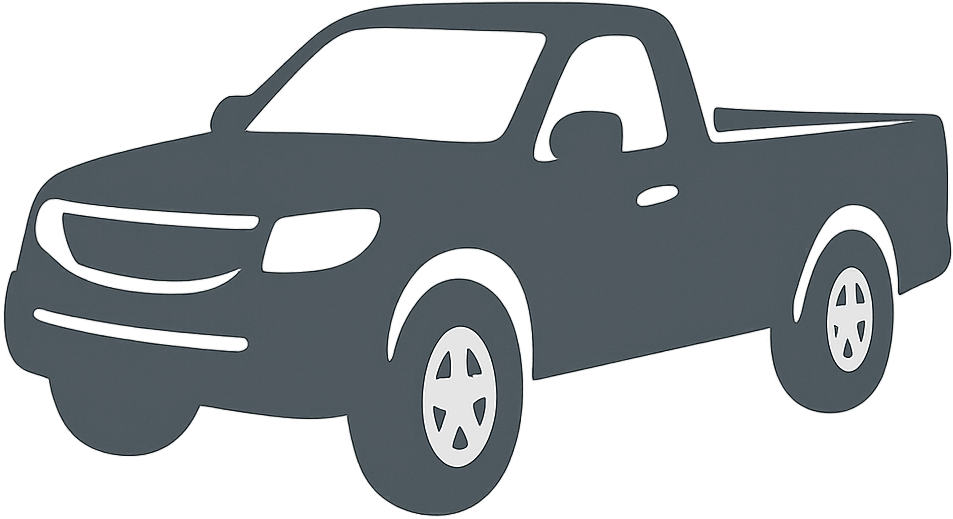 1990 Trabant 1.1 Pick-up Dimensions, Size & Specs
1990 Trabant 1.1 Pick-up Dimensions, Size & Specs
Measurements of the 1990 Trabant 1.1 Pick-up, engineered for optimal performance and comfort
| Dimensions | |
|---|---|
| Length: | 3521 mm138.6 in11.6 ft |
| Width: | 1528 mm60.2 in5.0 ft |
| Height: | 1420 mm55.9 in4.7 ft |
| Trunk Capacity (Max): | 415 liter14.7 cu ft |
| Weight Specifications | |
| Curb Weight: | 680 kg1499 lbs |
| Maximal permitted Weight: | 1085 kg2392 lbs |
| Tire Specifications | |
| Rims Size: | Other Rims:
|
| Tire Size: |
|
The Trabant 1.1 Pick-up is a compact utility vehicle produced during a brief period from 1990 to 1991. Representing one of the final iterations of the iconic Trabant series, the 1.1 Pick-up retains its classic simplicity while offering practical cargo functionality as a small pickup truck. The vehicle measures 3521 mm (138.6 inches) in length, 1528 mm (60.1 inches) in width, and stands 1420 mm (55.9 inches) tall, making it notably compact by modern pickup standards. It features a lightweight construction, with a curb weight of only 680 kg (1499 lbs), and a maximum weight capacity of 1085 kg (2393 lbs), which provides a modest but useful payload capability especially for urban and light-duty transport tasks.
Its rear cargo area capacity, with the rear seats folded, totals approximately 415 liters, supporting reasonable storage for a small pickup, while the vehicle rides on 13-inch rims sized 4JX13H-45 fitted with 145/80 SR13 tires that contribute to its nimble handling and maneuverability. Despite the limited size and power compared to contemporary pickups, the Trabant 1.1 Pick-up remains a symbol of East German automotive history, prized for its simplicity, ease of maintenance, and practical design for carrying light loads.
Designed primarily for light commercial use in tight and constrained environments, this pickup combines the compact dimensions of its passenger car roots with the added flexibility of a pickup bed, making it an interesting choice for enthusiasts of vintage utilitarian vehicles. The Trabant 1.1 Pick-up’s minimalistic engineering and compact footprint illustrate an era of automotive design focused on efficiency and function over luxury or size. Overall, it serves as a quintessential example of small pickup trucks from the late 20th century Czechoslovakian automotive heritage.
Discover the standout features that make the 1990 Trabant 1.1 Pick-up a leader in its class
Have a question? Please check our knowledgebase first.
The Trabant 1.1 Pick-up measures 3521 mm (138.6 inches) in length, 1528 mm (60.1 inches) in width, and 1420 mm (55.9 inches) in height. These compact dimensions position it as a small utility vehicle suitable for tight urban environments and narrow roads, making it easy to maneuver and park.
The Trabant 1.1 Pick-up has a curb weight of 680 kg (1499 lbs), which reflects its lightweight design. Its maximum weight capacity is 1085 kg (2393 lbs), indicating it can carry a payload of approximately 405 kg (894 lbs). This makes it a practical choice for light utility tasks and transportation of small to medium loads.
With the rear seats folded down, the Trabant 1.1 Pick-up offers a luggage capacity of 415 liters (approximately 14.7 cubic feet). This sizable cargo space allows for the transport of goods or equipment, especially useful for a compact pickup truck designed for modest hauling needs.
Yes, the Trabant 1.1 Pick-up fits comfortably into a standard garage. Given its compact length of 3521 mm (138.6 inches) and width of 1528 mm (60.1 inches), it requires minimal space compared to modern pickup trucks. Most standard garages, which usually accommodate vehicles up to 6 meters in length and 2.5 meters in width, will have no trouble housing this vehicle.
The width of the Trabant 1.1 Pick-up is 1528 mm (60.1 inches), which is narrower than many average cars from the early 1990s that typically ranged between 1650 mm to 1800 mm (65 to 70.8 inches). This narrow width reflects its design for urban utility and ease of maneuverability on narrow roads, a common feature in Eastern European vehicles of that time.
The Trabant 1.1 Pick-up is equipped with 4JX13H-45 rims and uses 145/80 SR13 tires. These 13-inch tires (approximately 33 cm in diameter) contribute to its lightweight and compact design, which enhances fuel efficiency and ease of driving in tight conditions while ensuring appropriate grip and stability for a city-focused pickup truck.
The Trabant 1.1 Pick-up maintained the tradition of the Trabant brand's compact dimensions but introduced a pickup body style that slightly altered its cargo and cabin arrangement. Compared to previous Trabant models like the Trabant 601, which featured a sedan body, the 1.1 Pick-up offers more practical utility with its cargo bed while keeping a similar footprint in terms of length and width, though its height and weight differ slightly due to the structural changes required for the pickup adaptation.
When compared to similar compact pickups like the Suzuki Carry or the Daihatsu Hijet from the early 1990s, the Trabant 1.1 Pick-up is generally smaller and lighter. Its 3521 mm length and 680 kg curb weight make it easy to handle, but it offers less powerful engines and simpler construction. While its payload capacity and cargo volume are modest, it stands out for its simplicity and affordability, though it lacks some refinements and modern features found in Japanese counterparts.
The Trabant 1.1 Pick-up is a small pickup truck produced between 1990 and 1991. It served as a practical utility vehicle primarily targeting the needs of light commercial use and customers requiring a small but capable cargo transporter during a time when Trabant was transitioning its lineup before ceasing production.
Distinctive features of the Trabant 1.1 Pick-up include its characteristic small size, lightweight construction, and pickup truck configuration, which offered a blend of passenger car comfort and light cargo utility. It retained the simple, utilitarian design typical of Trabants, emphasizing affordability and practicality over luxury. Its compact size made it ideal for urban deliveries and small-scale hauling, especially in regions where narrow roads and limited parking space were common.
